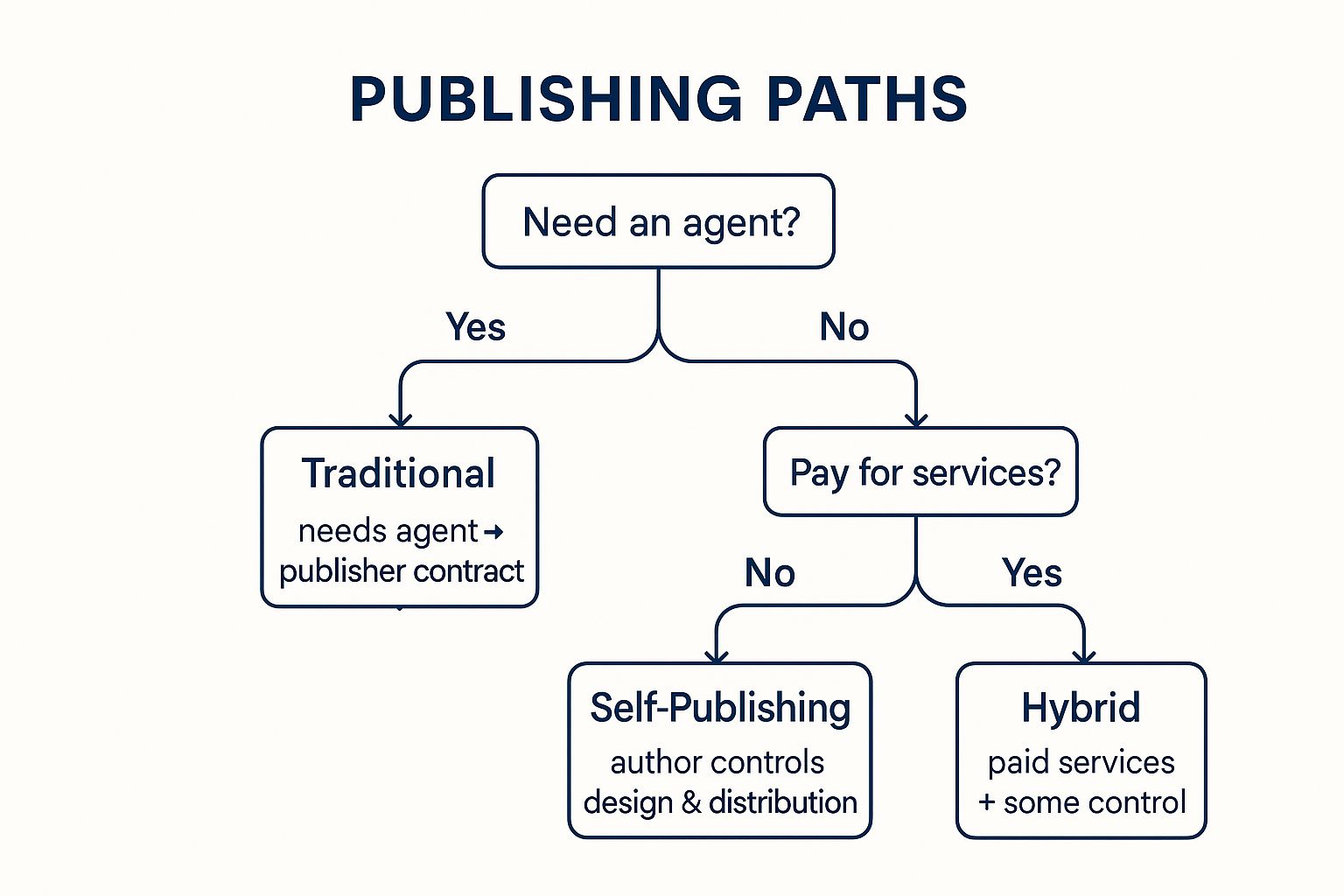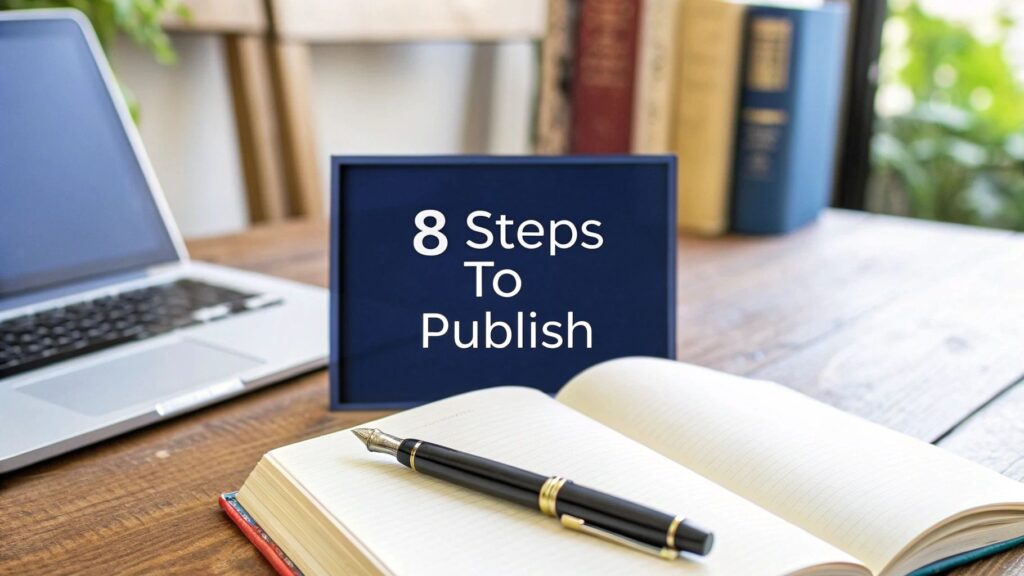The dream of holding your own published book is closer than you think. Yet, the journey from a completed manuscript to a book in readers' hands can feel like a complex maze. Many aspiring authors have brilliant ideas but get stuck on the practical execution, unsure of what comes after typing "The End." This guide demystifies the entire process, breaking it down into a clear, sequential roadmap.
You will learn the specific steps to publishing a book, from initial manuscript refinement and professional editing to the critical details of cover design, copyright registration, and global distribution. We provide actionable insights for navigating the modern publishing landscape, whether you are pursuing a traditional deal or choosing to self-publish. Each stage is presented with practical implementation details to guide you forward confidently.
This comprehensive list is designed to transform your authorial aspirations into a tangible, professionally produced reality. For those seeking expert guidance, comprehensive services are available to manage this entire process, turning a finished manuscript into a market-ready book. Following these steps will equip you with the knowledge needed to successfully bring your story to the world.
1. Write and Complete Your Manuscript
Before any other steps to publishing a book can begin, you must have a finished manuscript. This foundational stage is where your idea evolves from a concept into a complete, written draft. It’s the raw material that will eventually be shaped, polished, and packaged for readers.
The process of writing a manuscript varies significantly between fiction and non-fiction. Fiction authors focus on world-building, character arcs, and narrative structure, while non-fiction writers concentrate on meticulous research, logical organization, and presenting complex information in an accessible way. Regardless of genre, this stage demands discipline and a structured approach.
Key Strategies for Manuscript Completion
To move from a blank page to a finished draft, you need a system. The goal is not perfection, but completion. As author Anne Lamott advises in Bird by Bird, embrace the "shitty first draft" to overcome the paralysis of trying to write perfectly from the start.
- Establish a Consistent Routine: Dedicate a specific time each day to writing. This builds momentum and turns writing into a habit. Stephen King famously adheres to a daily 2,000-word quota, a testament to the power of consistency.
- Set Achievable Goals: Aim for a manageable daily word count, such as 500-1,000 words. This prevents burnout and provides a regular sense of accomplishment.
- Separate Writing from Editing: During the first draft, your sole focus should be getting the story or information down on the page. Resist the urge to edit as you go, as this can stifle creative flow and slow your progress.
- Utilize Organizational Tools: Software like Scrivener, Google Docs, or Ulysses can help you organize chapters, research, and character notes, keeping your project manageable.
This initial writing phase is the most creative yet demanding part of the journey. For a deeper dive into structuring your work, explore the detailed book writing process on barkerbooks.com.
2. Professional Editing and Proofreading
Once your manuscript is complete, the next critical step to publishing a book is professional editing. This stage elevates a raw draft into a polished, coherent, and market-ready piece of writing. It involves multiple layers of review, each addressing different aspects of the text, from big-picture narrative structure to minute grammatical details. Skipping this step is one of the most common mistakes aspiring authors make.

This process is not a single action but a sequence of specialized tasks. Developmental editing tackles the story's core elements like plot and pacing. Line editing refines prose at the sentence level for clarity and impact. Copy editing corrects grammar, spelling, and consistency. Finally, proofreading catches any lingering errors before printing. Every successful book, from those published by Random House to self-published hits like Andy Weir's The Martian, undergoes rigorous editing.
Key Strategies for Effective Editing
Engaging a professional editor is an investment in your book's quality and credibility. To ensure the best outcome, approach this phase with a clear strategy. The goal is to collaborate with an expert who understands your vision and can help you execute it flawlessly.
- Budget Appropriately: Set aside a significant portion of your publishing budget for editing. Quality editing can be the difference between a professional product and an amateur one. A common guideline is to allocate around 10-15% of your total budget.
- Request Sample Edits: Before committing to an editor, ask for a sample edit of a few pages. This allows you to assess their style, attention to detail, and compatibility with your voice. Marketplaces like Reedsy facilitate this process.
- Allow Ample Time: Professional editing is not a rushed process. Plan for each major editing phase to take approximately 4-6 weeks. This timeline gives both you and your editor the necessary space to refine the manuscript effectively.
- Consider Specialized Editors: You might hire a developmental editor for structural feedback and a different professional for copy editing and proofreading. Using specialists for each stage can provide a more thorough and robust result.
Navigating the different types of editing is fundamental to producing a high-quality book. For a deeper understanding of these distinct but related processes, you can find a comprehensive breakdown of the differences between proofreading and editing at barkerbooks.com.
3. Design Professional Cover and Interior Layout
After editing, the next of the critical steps to publishing a book is creating its visual presentation. This includes both the cover, which is your primary marketing tool, and the interior layout, which ensures a seamless reading experience. A professional design signals quality to potential readers and can be the deciding factor in whether someone buys your book or scrolls past it.

Your book cover must instantly communicate the genre and tone while standing out in a crowded digital marketplace. The interior design, or typesetting, must be clean, readable, and appropriately formatted for both print and ebook editions. These two elements work together to create a polished, professional product that can compete with traditionally published titles.
Key Strategies for Professional Book Design
Investing in professional design is one of the wisest decisions a self-publishing author can make. While DIY tools like Canva exist, the expertise of a designer experienced in book covers and interior formatting is invaluable.
- Study Your Genre: Analyze the top-selling book covers in your category on Amazon or Goodreads. Note common color schemes, typography, and imagery. Your cover should fit reader expectations while still having a unique hook.
- Prioritize Thumbnail Readability: Most readers will first see your cover as a small thumbnail online. Ensure the title and author's name are legible at a small size and the core imagery is clear.
- Invest in Professional Services: Platforms like Reedsy or 99designs connect authors with vetted professional designers. Many self-published authors find success by hiring separate specialists for cover design and interior layout to ensure expertise in both areas.
- Focus on Interior Readability: Professional interior layout involves more than just choosing a font. It includes proper margins, line spacing, justification, and chapter headings. This ensures the text is easy on the eyes, preventing reader fatigue and enhancing the overall experience.
4. Choose Your Publishing Path
With a polished manuscript in hand, you arrive at a critical crossroads in the steps to publishing a book: selecting your publishing path. This decision fundamentally shapes your entire journey, impacting your creative control, financial investment, timeline, and marketing responsibilities. The three primary routes are traditional publishing, self-publishing, and hybrid publishing, each with distinct advantages and drawbacks.
This infographic breaks down the core decision points that differentiate each publishing path, from securing an agent to managing distribution.

This decision tree illustrates how your priorities, whether it's avoiding upfront costs or retaining full creative and financial control, directly lead you to a specific publishing model.
Key Strategies for Choosing Your Path
Making an informed choice requires a clear understanding of your personal goals, resources, and willingness to manage the business side of authorship. As publishing expert Jane Friedman advises, there is no single "best" path, only the path that is best for you and your specific book.
- Assess Your Goals and Resources: Traditional publishing with houses like Penguin Random House or HarperCollins offers prestige and no upfront costs but cedes significant control and pays lower royalties. Self-publishing via platforms like Amazon KDP or IngramSpark gives you full control and higher royalties but requires you to fund and manage the entire process.
- Evaluate Your Timeline and Skills: The traditional route can take years, from finding an agent to seeing your book in stores. Self-publishing can be accomplished in a matter of months. Honestly assess your skills in marketing, design, and project management, as these are essential for self-publishing success.
- Consider a Hybrid Approach: Hybrid publishers like She Writes Press or BookBaby offer a middle ground, combining the professional services of traditional publishing with the author-funded model of self-publishing. This can be a good option if you want expert support but prefer to maintain more control and speed up the timeline.
- Start Building Your Platform Now: Regardless of the path you choose, a strong author platform (your connection to your readers) is invaluable. Start building your email list, social media presence, and author website early, as publishers and readers alike are drawn to authors who have an engaged audience.
This decision is one of the most significant a writer will make. For a comprehensive comparison of these models, publishing industry analyst Jane Friedman offers invaluable insights on her website.
5. Secure ISBN and Copyright Protection
Once your manuscript is professionally edited and nearing its final form, the next of the essential steps to publishing a book involves securing its legal and commercial identity. This means obtaining an International Standard Book Number (ISBN) and officially registering your copyright. These identifiers are non-negotiable for serious authors aiming for broad distribution and legal protection.
An ISBN is a unique 13-digit code that retailers, libraries, and distributors use to track and manage your book. Without it, your book cannot be sold in most major bookstores or online platforms. Copyright registration, handled by the U.S. Copyright Office, provides a public record of your ownership and is a prerequisite for filing an infringement lawsuit, offering you the strongest possible legal protection for your creative work.
Key Strategies for ISBN and Copyright
Navigating these administrative tasks correctly establishes you as the official publisher of your work and safeguards your intellectual property. While some platforms offer free ISBNs, purchasing your own ensures you retain full control.
- Purchase ISBNs Directly: In the United States, Bowker is the only official source for ISBNs. Buying a block of 10 is far more cost-effective than buying a single one, which is ideal if you plan to publish multiple formats (ebook, paperback, hardcover) or future books.
- Register Copyright Pre-Publication: While your work is technically copyrighted the moment it's created, formal registration with the U.S. Copyright Office is crucial. Registering before publication (or within three months of it) allows you to claim statutory damages and attorney's fees in a successful infringement case.
- Use Your Own ISBN: Using a free ISBN from a platform like KDP often lists them as the publisher, which can limit your distribution options. Owning your ISBN lists you or your publishing company as the publisher of record, giving you maximum flexibility.
- Maintain Detailed Records: Keep a secure digital and physical record of your ISBN assignments, copyright registration certificate, and any related confirmation numbers. This documentation is vital for your business records.
Properly handling these legal and commercial formalities is a critical step. While copyright protects your book's content, you might also want to explore the nuances of trademarking a book title for additional brand protection, especially if you plan on building a series.
6. Set Up Distribution Channels
Once your book is designed and formatted, the next crucial step is establishing the pathways to get it into the hands of readers. Distribution is the commercial engine of publishing, determining how and where your book is available for purchase. This involves selecting platforms and services that will list, print, and deliver your book to customers worldwide.
Proper distribution setup ensures your book is accessible on major online retailers and can be ordered by physical bookstores and libraries. It's the bridge connecting your finished product to your target audience. Your choice of distributors directly impacts your book's reach, royalty rates, and overall market presence, making this one of the most critical logistical steps to publishing a book.
Key Strategies for Book Distribution
Your distribution strategy will depend on your goals, whether you prioritize a wide reach or exclusive perks on a single platform. The key is to make your book as easy to find and buy as possible for your ideal reader.
- Select Your Core Platforms: Most self-publishers start with Amazon's Kindle Direct Publishing (KDP) for its enormous market share in both e-book and print-on-demand sales. To reach beyond Amazon, IngramSpark is the industry standard for making your book available to over 40,000 bookstores, libraries, and online retailers globally.
- Use Aggregators for E-books: Instead of uploading your e-book to every retailer individually, an aggregator like Draft2Digital distributes it to a wide network, including Apple Books, Barnes & Noble, and Kobo, from a single dashboard. Once your book is ready, identifying the optimal platforms is crucial for reaching your audience. You'll want to explore the best places to sell eBooks to maximize your sales potential.
- Optimize Your Book's Metadata: Ensure your book's title, subtitle, author name, description, and keywords are consistent and optimized across all platforms. Accurate and compelling metadata is essential for searchability and discoverability.
- Decide Between Exclusive and Wide Distribution: Enrolling in Amazon's KDP Select program offers promotional benefits but requires you to sell your e-book exclusively on their platform. A "wide" strategy forgoes these perks in favor of reaching readers on all retail sites.
Choosing the right partners is fundamental to a successful launch. For a comprehensive overview of your options, you can explore various book distribution services on barkerbooks.com.
7. Develop and Execute Marketing Strategy
With a polished manuscript and a stunning cover, the focus shifts to ensuring your book finds its audience. This is where a strategic marketing plan becomes one of the most critical steps to publishing a book. Marketing isn't just a post-launch activity; it's a comprehensive effort to build anticipation, drive sales, and create a lasting connection with readers.
A well-executed marketing strategy bridges the gap between your finished book and the people who want to read it. For fiction authors, this might involve engaging with genre communities online, while non-fiction writers may focus on establishing authority through content and media appearances. The goal is to create sustained momentum that carries your book beyond its initial launch week.
Key Strategies for Book Marketing
A successful book launch is built on a foundation of early and consistent promotion. As author and marketing guru Tim Ferriss has demonstrated, a highly structured launch can transform a book from a simple release into a major event. You must build an audience before you need them to buy your book.
- Build Your Author Platform Early: Start building your online presence 6-12 months before your publication date. Create a professional website, secure your social media handles, and start an email newsletter to gather interested readers.
- Focus on Key Channels: Don't spread yourself too thin. Identify 2-3 marketing channels where your target readers are most active. This could be Bookstagram for visual genres, TikTok (BookTok) for YA and romance, or LinkedIn and podcasts for business non-fiction.
- Engage Authentically: Interact with potential readers, reviewers, and fellow authors. Join conversations, share valuable content, and build genuine relationships. Avoid a purely promotional approach; focus on community and connection.
- Leverage Reviews and Giveaways: Use platforms like Goodreads to run giveaways and build early reviews. Positive social proof is a powerful purchasing trigger for readers browsing for their next book.
Executing a marketing plan requires a mix of pre-launch buzz, a high-impact launch campaign, and ongoing promotional activities. For more on creating a powerful promotional plan, learn how to build an effective book marketing strategy on scribemedia.com.
8. Launch and Post-Launch Promotion
The book launch is not the finish line; it’s the starting gun. This crucial phase is a coordinated marketing push designed to generate maximum visibility, sales, and reviews in the critical first few weeks. A successful launch sets the stage for long-term success, while post-launch promotion maintains that momentum.
This step transitions your role from solely an author to a marketer. For both traditionally published and independent authors, the initial sales velocity can significantly influence a book's trajectory, impacting bestseller lists, retailer algorithms, and word-of-mouth buzz. Think of it as a concentrated burst of energy to get the flywheel spinning.
Key Strategies for a Successful Launch
A powerful launch requires careful planning and execution. The goal is to align all your marketing channels to peak simultaneously, creating a wave of interest. Marketing experts like Ryan Holiday have demonstrated how a well-orchestrated launch can turn a book into a perennial seller.
- Build a Pre-Launch Team: Assemble a group of early readers, often called a "street team" or "launch team." Provide them with advance reader copies (ARCs) in exchange for honest reviews on launch day.
- Coordinate Promotional Channels: Align your email marketing, social media posts, and any paid advertising to go live on or around your launch date. Successful indie authors often use their email lists as their primary launch tool.
- Time Your Launch Strategically: Avoid launching during major holidays or when a blockbuster book in your genre is being released. A Tuesday launch is common, as it aligns with industry sales tracking cycles.
- Plan for Post-Launch Momentum: The work doesn't stop after launch week. Continue engaging with readers, seek promotional opportunities like a BookBub Featured Deal, and run targeted ads to keep sales steady.
Effectively managing these promotional efforts is one of the most vital steps to publishing a book that finds its audience. It transforms a quiet release into a noteworthy event. For more on building an audience, consider Tim Grahl's insights on creating a platform.
8-Step Book Publishing Process Comparison
| Step / Item | Implementation Complexity 🔄 | Resource Requirements ⚡ | Expected Outcomes 📊 | Ideal Use Cases 💡 | Key Advantages ⭐ |
|---|---|---|---|---|---|
| Write and Complete Your Manuscript | High – requires discipline, time (6 months+) | Mostly personal time and focus | Complete manuscript draft, established voice | Initial book creation, foundational work | Establishes core content and style |
| Professional Editing and Proofreading | Moderate to high – multiple editing rounds | Financial investment ($1,000-$5,000+), professional editors | Polished, publish-ready manuscript | Improving manuscript quality and readiness for publishing | Significantly enhances quality and readability |
| Design Professional Cover and Interior Layout | Moderate – design skills or hiring pros | Financial investment ($300-$2,000+), design tools | Attractive cover, well-formatted interior | Marketing appeal, reader experience improvement | Boosts sales potential and professional appearance |
| Choose Your Publishing Path | Moderate – requires research and decision making | Varies by path: agent costs, self-publishing fees | Clear publishing route, royalty decisions | Deciding traditional, self, or hybrid publishing | Aligns publishing approach with goals and resources |
| Secure ISBN and Copyright Protection | Low to moderate – paperwork and fees | Purchase ISBNs ($125-$300+), copyright registration fees ($45-$125) | Legal protection, market identification | Legal compliance, wide distribution | Ensures legal ownership and professional credibility |
| Set Up Distribution Channels | Moderate – multi-platform setup and optimization | Time and platform fees | Broad book availability and sales reach | Expanding market reach across formats | Global reach with minimized inventory risks |
| Develop and Execute Marketing Strategy | High – ongoing, multifaceted efforts | Time, often monetary for ads and tools | Raised awareness, sales growth, author platform | Building readership and sales pre- and post-launch | Increases visibility and sales potential |
| Launch and Post-Launch Promotion | High – intense coordination and timing | Significant time, promotion resources | Strong launch sales, sustained momentum | Maximizing initial book impact and long-term success | Drives critical early sales and ongoing exposure |
Bringing Your Story to the World
The journey from a completed manuscript to a published book in the hands of readers is a formidable, yet immensely rewarding, undertaking. As we have explored, the process is far more than just writing. It is a multi-stage marathon that demands creativity, strategic planning, and meticulous execution at every turn. Successfully navigating these steps to publishing a book is what separates an aspiring writer from a published author whose work can inform, entertain, and inspire a global audience.
From Manuscript to Masterpiece: A Recap of Your Journey
Your path to publication is built upon a sequence of critical milestones. It begins with the solitary, disciplined act of completing your manuscript and then moves into the vital collaborative phase of professional editing. This is where your raw story is polished into a professional, error-free narrative that respects your reader's time and attention. From there, the visual identity of your book takes shape through professional cover design and interior layout, elements that are crucial for making a strong first impression in a crowded market.
The strategic decisions continue as you choose your publishing path, whether traditional, hybrid, or self-publishing. Each route has distinct advantages, and your choice will influence your control, royalties, and timeline. Securing your intellectual property with an ISBN and copyright registration is a non-negotiable step that formalizes your ownership and prepares your book for commercial distribution. Finally, your launch is not an endpoint but a beginning. A well-executed marketing and distribution strategy ensures your book finds its intended audience and continues to sell long after its release day.
The Author's Mindset: Beyond the To-Do List
Ultimately, publishing a book is an act of profound vulnerability and incredible courage. You are not just assembling words on a page; you are sharing a piece of your intellect, your imagination, and your heart with the world. The process will test your resilience and your resolve. There will be moments of doubt and unforeseen challenges, but the key is to view each step not as a hurdle, but as an opportunity to learn and grow as a creative professional.
Key Takeaway: Publishing is a business. Approaching each step with a professional, strategic mindset, from editing to marketing, is just as important as the creative act of writing itself. It transforms your passion project into a viable product with the potential for lasting impact.
By internalizing and systematically applying these foundational steps, you are no longer just hoping for success; you are actively engineering it. You are empowering yourself with the knowledge to make informed decisions, avoid common pitfalls, and build a sustainable career as an author. The world is waiting for your unique voice and the story only you can tell. Embrace this detailed roadmap, take the next logical step, and move forward with the confidence that you have a clear and actionable plan to bring your book to life.
Navigating the complexities of publishing can be overwhelming, but you don't have to do it alone. If you're looking for an expert partner to manage every detail, from professional editing and design to global distribution and marketing, BarkerBooks offers comprehensive publishing solutions tailored to your unique goals. Transform your manuscript into a professionally published book by visiting BarkerBooks to see how we can help you share your story with the world.
